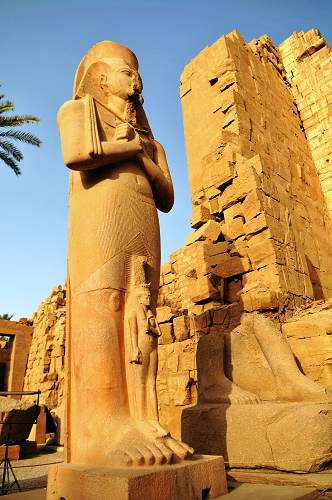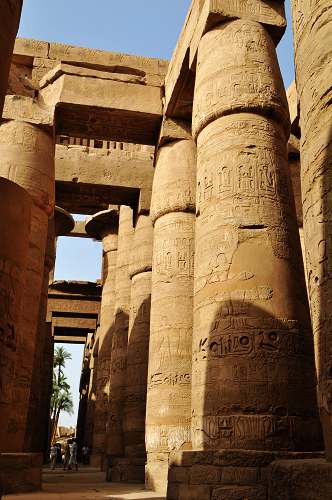Luxor is one of Egypt's great tourist attractions. It is commonly known as the world's largest open air museum. It has some of the most important archeological attractions of the world. The Valley of the Kings, the Valley of the Queens and the Tombs of the Noble are unique highlights of the ancient Egyptian Civilization. These complexes of graves and tombs are located 20 km west of town, at the other side of the Nile. The most famous of these tombs is of course that of Tutankamon. Luxor is built on and around the ancient site of Thebes. Luxor is actually three separate areas each with their own highlights.

ID:108070-01440 Krnak Tmple Picture Sources:ccnpic.com Tian Zhan
Luxor Temple
Situated in the center of town, was built by the New Kingdom Pharaoh Amenophis III. The beautiful Luxor Temple built by Amenhotep III (1390-1352 BC) on the site of an earlier sanctuary raised by Hatshepsut in the 15th century BC. The temple was added to by Ramses II, Alexander the Great and the Romans, and is a graceful and striking piece of architecture. It has four pillared courts and hypostyle halls of great beauty, and in front of the enormous first pylon are some colossal granite statues of Ramses II and a pink granite obelisk – the partner of which was removed to Paris's Place de la Concorde. In the Great Court is a 13th century mosque. The Luxor Museum houses many of the relics found at the Theben temples and necropolis on the west bank.

ID:108070-01424 Krnak Tmple Picture Sources:ccnpic.com Tian Zhan
karnak temple
North of Luxor city are the spectacular Temples of Karnak. In ancient times, Karnak was known as Ipet-isut, 'The most select of places'. The temple complex of Karnak was built over a time period of 1500 years and was the most important place of worship in ancient Egypt. The site is huge, measuring 1500 x 800 meters, and is a spectacular complex of sanctuaries, kiosks, pylons and obelisks, all dedicated to the Theban gods. It is thought to be the largest surviving religious complex in the world.

ID:111131-01535 Krnak Tmple Picture Sources:ccnpic.com Wang Lu

ID:108070-01441 Krnak Tmple Picture Sources:ccnpic.com Tian Zhan
Ancient Thebes (West Bank)
Crossing the Nile to the West of the city of Luxor lies the necropolis of ancient Thebes. There is three tombs at the major archaelogical sites.
The Valley of the Kings
This is where the pharaoh's were buried and hoped to meet their Gods in the afterlife. Tutankhamun's tomb discovered in the 1920's almost untouched is perhaps the best known to most of us non-archaeologists. But he was a minor king in the scheme of things and had it not been for centuries of looting, the larger more impressive tombs would have yielded riches unsurpassed to the impressive haul found in King Tut's burial ground. For a complete list of tombs that are open to the public in the Valley of the Kings see this list from the Egyptian Monuments site.

ID:111131-01525 Krnak Tmple Picture Sources:ccnpic.com Wang Lu
The Valley of the Queens
The Valley of the Queens lies at the southern end of the necropolis. This is where the queens and their children were interred. Only four tombs are open to the public in the Valley of the Queens and if you had to choose just one, it would have to be Queen Nefertari's tomb.
The Colossi of Memnon
Two giant statues make up the Colossi of Memnon. Most visitors get a glimpse of them on their way to the Valley of the Kings but it is worth a stop to see them up close.
Tips:
When to Go: Horse races, Pharaonic processions and weddings in the temple.
West Bank marathon (Feb), Moulid of Abu el-Haggag (two weeks before Ramadan), Pharaonic Wedding Festival (May & Nov), Luxor National Day (Nov).
(CCNPIC Nancy Wu)
(Article Resource: www.ccnpic.com)